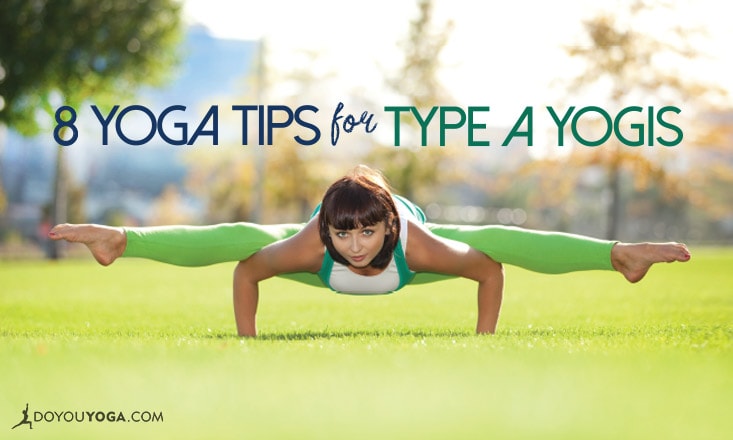Type A is used to describe someone's personality type or disposition. Often characterised by qualities such as competitiveness, having a sense of urgency, being reactive as well as impatient, it’s no wonder so many of us are naturally drawn to yoga.
While yoga can give us the balance we don’t always (if ever) give ourselves, Type A’s often approach our practice the same way we do everything else: with drive, determination and a strong desire to be really good, really fast.
As someone with Type A tendencies, I’ve worked really hard (of course I have) to create a more balanced approach to my life through my yoga practice. And I’ve learnt that the way we practice is oftentimes more important than what we practice. So for yogis with type A personality, here are a few tips to bear in mind next time you’re on the mat.
1. Slow. Down.
Yoga is a not a race and there is no prize. A sense of urgency might serve you well in your work, but there’s no need for it on the mat. So move slowly, both on your way to yoga as well as while you’re practicing.
2. It’s okay to skip a practice.
I know, this one’s hard to stomach because damn it, I said I was going to practice today so I WILL practice today! If situations have come up than mean your practice will be compromised for a day, rather than getting wound up and creating more stress and pressure, simply let it go.
If you really want to practice yoga, just sit and close your eyes and watch your breath for a few minutes.
3. Let go of goals and outcomes.
Everything might be so much more rewarding or fulfilling when you’re working towards a goal, but given your highly driven, motivated and disciplined approach to most other things in life, instead try approaching your yoga practice without agenda.
It really doesn’t matter how many weeks or months it takes you to get up into Handstand, so instead just see what happens in each moment and take each class as it comes.
4. Be present.
Being present is quite possibly one of the most challenging things for a Type A person to do. The thing about being present, is that we need to let go of ideas, plans, to do lists and as mentioned previously, outcomes and goals. We replace that mind activity with the simple act of observation, which might not be easy but it is so worth it.
5. Release the need to micro manage your yoga practice. Let it come to you.
You’re on your way to yoga, and you just know it’s going to be a perfect class. You’ve made sure you’re early so you can nab your favourite spot and your favourite teacher is teaching your favourite style of yoga, you can just see if all going according to plan!
Err…what happens when you get there and find our your teacher is sick so you’ve got a sub, and to make matters worse someone else is already in “your” spot?
I say this because I totally understand what it’s like to try to micro manage every aspect of life, including yoga. So try to just let go of your controlling tendencies (this is a practice in itself) and just let whatever is meant to happen come to you.
6. Try a yin or restorative class.
I bet you love Vinyasa Flow, Ashtanga, Power Yoga or Hot Yoga right? Yep me too, but guess what is going to balance you out even more? If you haven’t tried Restorative or Yin yoga then I thoroughly recommend you give one of these slower, relaxing styles a go. They are challenging at first, but in my experience they leave me feeling so much more balanced and nourished, on the inside as well as out.
7. Meditate
I don’t know numbers and I haven’t done a survey, but most people that I’ve met who suffer from anxiety and stress are from the Type A world. And given stress and anxiety start in the mind, it makes sense to find a practice to soothe and relax the grey matter.
There is nothing more soothing to a busy, overactive mind than a few moments of stillness.~Anna Coventry
Just sitting down and asking the mind to stop for some of us is next to impossible, but with a specific practice – aka meditation – it becomes easier. And the moments of peace and stillness, are so worth the effort.
8. Practice guided relaxation techniques
Guided relaxation techniques soothe us in much the same way as meditation does, but they can be a little more accessible for many of us because all we need to do is lie down and listen to someone’s voice.
Guided relaxations are perfect to do at the end of a busy day or before you go to sleep as they give both your body and your mind a chance to unwind, let go and drift off into a more relaxed slumber.
Remember it’s not always what we practice, it’s how we practice that can have the most powerful effect. And I found that by approaching my yoga practice in a slower, quieter, more relaxed way, I was able to create a more balanced approach to my life off the mat.


